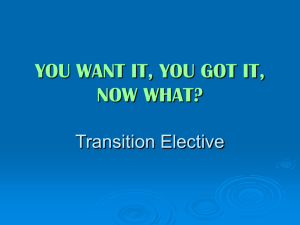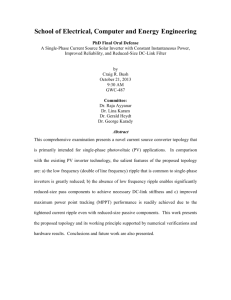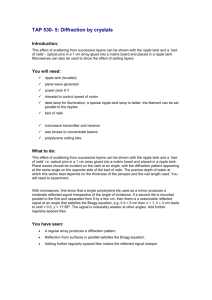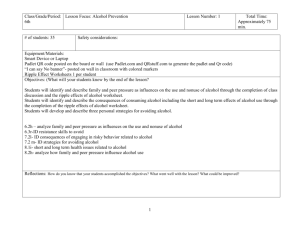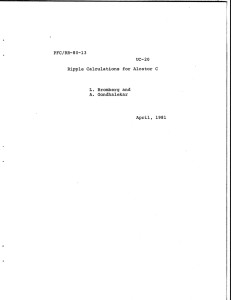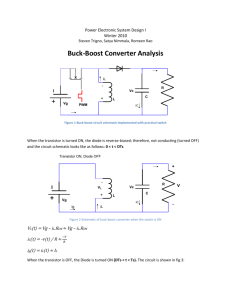Mapping the Impacts of Extension Programs
advertisement
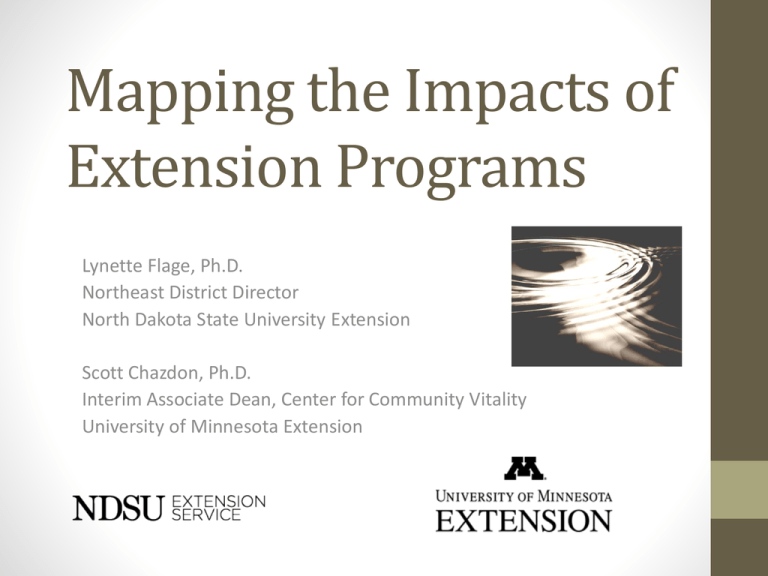
Mapping the Impacts of Extension Programs Lynette Flage, Ph.D. Northeast District Director North Dakota State University Extension Scott Chazdon, Ph.D. Interim Associate Dean, Center for Community Vitality University of Minnesota Extension Webinar Overview • Background of Ripple Effect Mapping • Description of the Method • Benefits and limitations • Examples Background of the Method • Qualitative method • Form of mind mapping • Ideal for brainstorming and organizing • Used in Horizons communities in Washington, Idaho and North Dakota • Variations Mind Mapping – Radiant Thinking Pictorial Method • Note taking • Brainstorming • Organizing • Problem solving • Evaluation Image: Mindmap, Graham Burnett, http://en.wikipedia.org/wiki/File:Mindmap.gif Relatives of Ripple Effect Mapping • Outcome mapping (OM) • Concept mapping • Participatory Impact Pathways Analysis (PIPA) Ripple Effect Mapping • Purpose – to better understand intended and unintended results of the (Extension program) for individuals, groups, communities and regions. • Completed post-program as part of impact evaluation How Does it Work? • Identify the intervention • Schedule the event and invite participants • Interviews/focus groups held • Mapping • Cleaning, Coding, Analysis Variations Participant Recruitment Interview /Focus Group Process Coding Program participants Appreciative Inquiry with or without pairs Community Capitals Non-participant stakeholders Probing around Community capitals Short-medium-long term outcomes Other Free flow – probes nonspecific Three legs of sustainability Other Triple bottom line Other Ripple Effect Map of the Naturally Occurring Retirement Communities Collaborative Ripple Effect Map of Fort Yates, ND Horizons Program Built Capital Natural Capital soil, air, environment Financial Capital housing, water, sewer, transportation and other infrastructure investments of wealth for the future Healthy Ecosystem Vital Economy Social Well-Being Healthy People Cultural Capital community & regional heritage, interconnections with others. Political Capital local politics to build partnerships to advocate for local issues Social Capital Human Capital individuals’ knowledge and skills healthy interactions to make people feel welcome Flora, C. B. & Flora, J. (2008). Community Capitals Framework Benefits of mapping the ripple effects • Simple and inexpensive tool • Activities are connected to a larger purpose • Shows public value of the program • Considers what is still needed • Encourages hopefulness • Opportunity for reflection & growth • Value realized to community • Group validation • Captures unintended outcomes and impacts • Shows total impact of the program Direct & Indirect Impacts • Extension programs often build social capital but don’t take credit for it. • People do not act in isolation – strengthened social capital is a necessary pre-condition for other impacts. • Other impacts may occur that were not foreseen in program theory. Limitations of mapping the ripple effects • Risk of bias in participant section and data collection • Participants may not have complete information about a program or program outcomes • Potential for inconsistency in implementation Examples • Horizons program • 4-H program mapping • Minnesota programs – BR&E map, Social Service collaborative • Leadership programs Mind Mapping Software • www.xmind.net (free or $49/year – professional) • Freemind • www.mindjet.com ($20/month) • www.mindmeister.com (free) • IMindMap – www.thinkbuzan.com/us ($99-$225) Suggestions • Use same facilitator, recorder and “mapper” • Understand you will be “probing” for responses – think about some of those probes beforehand • Make decision prior to mapping whether to use community capitals as probes during group interviews • Recognize that Extension isn’t trying to take all credit for all change • It is important to probe for negatives Our Hopes • Start a Community of Practice • Extension professionals and others will use this regularly as an evaluation tool • Start discussion in the literature • Evaluation results published in various journals Discussion Questions • Can this be done virtually? • Is this more of a method or methodology? • What interventions might be good candidates for this approach? • Who would you invite? • What kind of questions would you ask to start the process? References • Baker, B., Calvert, M., Emery, M., Enfield, R., & Williams, B. (2011). Mapping the impact of youth on community development: What are we learning? [PowerPoint slides]. Retrieved from http://ncrcrd.msu.edu/uploads/files/133/Mapping%20Impact%20of%20Youth%20on%20C om%20Dev%2012-3-10.pdf • Buzan, T. (2003) The Mind Map Book. London: BBC Books. • Cooperrider, D.L. & Whitney, D. 2007 Appreciative Inquiry: A Positive Revolution in Change. Pp. 73-88 in P. Holman & T. Devane (eds.), The Change Handbook, 2nd edition. San Francisco: Berrett-Koehler Publishers, Inc. • Douthwaite, B., Alvarez, S., Thiele, G., & MacKay, R. (2008). Participatory impact pathways analysis: A practical method for project planning and evaluation. ILAC Brief 17. • Emery, M., & Flora, C.B. (2006). Spiraling-up: Mapping community transformation with community capitals framework. Community Development: Journal of the Community Development Society 37(1), 19-35. • Eppler, M.J. (2006). A Comparison Between Concept Maps, Mind Maps, Conceptual Diagrams, and Visual Metaphors as Complementary Tools for Knowledge Construction and Sharing. Information Visualization 5:202-210. • Hearn, S. (2010). Introduction to outcome mapping. Presentation on http://www.outcomemaping.ca • Kollock, D. A. (2011). Ripple effects mapping for evaluation. Washington State University curriculum. Pullman, WA. • Outcome Mapping Learning Community. (2011). http://www.outcomemapping.ca Contact information Lynette Flage, Ph.D. Northeast District Director North Dakota State University Extension 701-780-8299 lynette.flage@ndsu.edu Scott Chazdon, Ph.D. Interim Associate Dean, Center for Community Vitality University of Minnesota Extension 612-624-0982 schazdon@umn.edu





